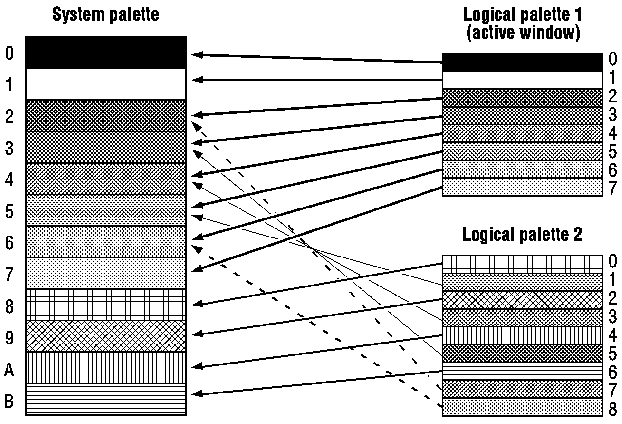
Color palettes provide a device-independent method for accessing the color capabilities of a display device by managing the physical, or system, palette of the device, if one is available. Typically, devices that can display at least 256 colors use a system palette.
An application employs the system palette by creating and using one or more
logical palettes. Each entry in the system palette contains a specific color. Then,
instead of specifying an explicit value for a color when performing graphics operations, the application indicates which color is to be displayed by supplying an index into the logical palette.
Because more than one application can use logical palettes, it is possible that the total number of colors requested for display can exceed the capacity of the display device. Windows acts as a mediator among the applications.
When a window requests that its logical palette be given its requested colors (a process known as realizing its palette), Windows first matches entries in the logical palette to current entries in the system palette. If an exact match for a given logical palette entry is not possible, Windows sets the entry in the logical palette into an unused entry in the system palette.
When all entries in the system palette have been used, Windows takes the logical palette entries that do not exactly match and matches them as closely as possible to entries already in the system palette. To further aid color matching, Windows sets aside 20 static colors in the system palette (the default palette) to which it can match entries in a background palette.
Windows always satisfies the color requests of the foreground window first; this procedure ensures that the active window has the best color display possible. For the remaining windows, Windows satisfies the color requests of the window that most recently received the input focus, the window that was active before that one, and so on.
The following illustration shows this process. In this illustration, a hypothetical display has a system palette capable of containing 12 colors. The application that created Logical Palette 1 owns the active window and was the first to realize its logical palette, which consists of 8 colors. Because the active window was active when it realized its palette, Windows mapped all of the colors in Logical Palette 1 directly to the system palette.
Logical Palette 2 is owned by a window that realized its logical palette while it was inactive. Three of the colors (1, 3, and 5) in Logical Palette 2 were identical to colors in the system palette. To save space in the palette, Windows simply matched those colors to existing system colors when the second application realized its palette. Colors 0, 2, 4, and 6 were not already in the system palette, however, so Windows mapped those colors into the system palette. Because the system palette became full, Windows was not able to map the remaining two colors (which did not exactly match existing colors in the system palette) into the system palette. Instead, it matched them to the closest colors in the system palette.
